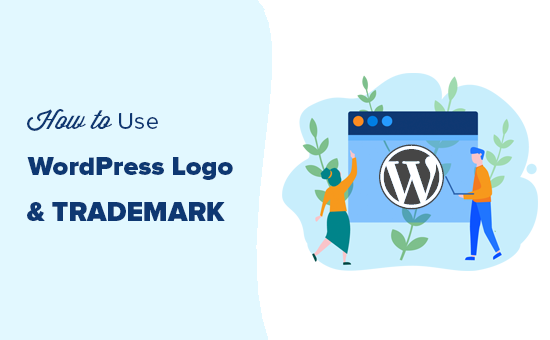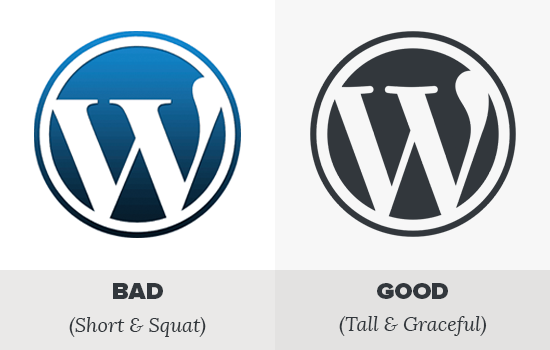The WordPress logo and trademark come with specific rules. Following these guidelines is essential for anyone sharing content about WordPress.
Although WordPress is open source, its name and logo are still protected by copyright and trademark laws. Many beginners don’t realize this and might accidentally overlook these important rules.
In this guide, we will cover the essential rules for using the WordPress logo and trademark, explain why these guidelines matter, and clarify your rights under the WordPress license.

Disclaimer: The information provided in this article is for general informational purposes only and is not intended as legal advice. For specific legal concerns regarding trademark or copyright matters, please consult a qualified attorney.
Understanding GPL – The WordPress License
Let’s start with the basics first.
There are two types of WordPress.
First, there is WordPress.com, which is a hosting company, and then there is the popular WordPress.org, also called self-hosted WordPress.
When most people say WordPress, they are talking about WordPress.org. To learn more, see our guide on the difference between WordPress.com and WordPress.org.
WordPress is released under the open-source GPL license. This makes WordPress a free software.
However, free here refers to freedom, not something like free coffee.
This license gives anyone the freedom to download, copy, use, study, and modify the WordPress code.

To summarize, the WordPress Bill of Rights guarantees these four freedoms:
- To run the program for any purpose.
- To study how the program works and change it to make it do what you wish.
- To redistribute.
- The freedom to distribute copies of your modified versions to others.
While the software itself is free to use, you will need to purchase a domain name and web hosting account to install WordPress and make a website.
To learn more, see our article explaining why WordPress is free and what the costs are.
There is a misconception among beginners about free software and copyright. While you are free to use the software code in any way you want, the software itself is protected by copyright and trademark laws.
What does that mean?
Basically, you can copy the WordPress code to make new software, but you cannot call your software WordPress.
The name WordPress is a registered trademark owned by the WordPress Foundation. It is a non-profit organization that ensures that WordPress runs successfully as a free, open-source project.
Why Do You Need to Understand WordPress Logo and Trademark Rules?
WordPress powers nearly 43% of all websites on the internet. That’s a really huge number.
Millions of businesses use WordPress to run their websites, online communities, and blogs effectively.
The WordPress brand and trademark need to be protected to ensure everything works smoothly. That’s why the WordPress trademark was transferred to the WordPress Foundation in 2010.
Now, the problem is that the WordPress Foundation is not the only one that works on WordPress. It is an open-source project where thousands of people contribute to its success.
Apart from those contributors, many companies, individuals, and freelancers worldwide sell WordPress-related products and services.
If you are running a WordPress website, a web design agency, or providing WordPress-related services, then you need to understand these rules to comply with the trademark policies.
That being said, let’s look at the rules and guidelines you must follow to use the WordPress trademark and logo in your projects properly:
Rule 1: Always Write WordPress with a Capital P
The correct way to spell WordPress is with a capital P. The WordPress community takes this capitalization very seriously.
If you are going to mention WordPress anywhere, then make sure that you use the correct spelling. Using an incorrect spelling is frowned upon and considered unprofessional.
WordPress team takes it so seriously that in 2010, they added a built-in filter called capital_P_dangit() in the WordPress 3.0 release.
This function automatically corrects the misspelled instances of WordPress in title, content, and excerpts:
function capital_P_dangit( $text ) {
// Simple replacement for titles
$current_filter = current_filter();
if ( 'the_title' === $current_filter || 'wp_title' === $current_filter ) {
return str_replace( 'Wordpress', 'WordPress', $text );
}
// Still here? Use the more judicious replacement
static $dblq = false;
if ( false === $dblq ) {
$dblq = _x( '“', 'opening curly double quote' );
}
return str_replace(
array( ' Wordpress', '‘Wordpress', $dblq . 'Wordpress', '>Wordpress', '(Wordpress' ),
array( ' WordPress', '‘WordPress', $dblq . 'WordPress', '>WordPress', '(WordPress' ),
$text
);
}
Rule 2: Do Not Use WordPress in Your Domain Name
As we mentioned earlier, the name WordPress is a registered trademark owned by the WordPress Foundation. This protects the WordPress brand and ensures its continued success.
Like any other registered trademark, the WordPress Foundation reserves exclusive usage rights for the term WordPress. This means you cannot use WordPress as part of your brand name or website.
This restriction also includes domain names. For example:
WordPressBeginner.com Wrong!
WPBeginner.com OK!
The WordPress Foundation website explains it in these words:
The abbreviation “WP” is not covered by the WordPress trademarks, but please don’t use it in a way that confuses people.
You can use WordPress in a subdomain such as (wordpress.example.com) as long as you are not claiming to be affiliated with or endorsed by the WordPress open-source project. The WordPress Foundation is mainly concerned with top-level domains.
If you see someone using WordPress in their domain name or brand name, then you should contact the WordPress Foundation and notify them about the violation.
See also: How to register a free domain name for your WordPress website.
Rule 3: The WordPress Logo
The WordPress logo consists of the letter W in a grey or sometimes white circle with a grey ring.
The height of the letter W is tall and graceful. Many bloggers and website owners sometimes mistakenly use the faux logo, which usually has a shorter W.

Make sure that you are using the correct WordPress logo in your projects.
The WordPress logo is also available as a text mark, text mark with the W logo, and W logo.

You can download all these logos from the official WordPress logos page (including WordPress logo PNG and SVG formats).
Feel free to use these images in your projects. However, make sure that you use them following the WordPress trademark policy.
Rule 4: No Affiliation or Endorsement
The WordPress Foundation wants you to use the WordPress logo and brand to promote the WordPress project itself.
However, you are not allowed to use it in a way that suggests endorsement or affiliation with the project. Here are some examples:
- You cannot use the WordPress logo in your product’s advertisements.
- You cannot use WordPress or its logo as part of your logo.
- You can place ‘Powered by WordPress.org’ on your website, but you cannot say ‘Recommended by WordPress.’
In easier words, any attempts to take unfair advantage of the WordPress brand name violate the trademark policy.
What Happens When Someone Doesn’t Follow These Rules?
The WordPress Foundation takes these violations very seriously. You may receive an email from them asking you to comply with their trademark guidelines.
Failure to comply may lead to further actions, including several legal procedures.
For example, if you use WordPress in your domain name, then the Foundation can claim that domain name. Their lawyers can also send you a legal notice.
The legal proceedings would cost you a lot of money, and you would lose support from the WordPress community itself.
The community relies on the WordPress Foundation to take these actions. It benefits everyone in the ecosystem and helps countless WordPress-related companies grow and succeed.
Additional Resources
- The Complete History of WordPress (with Screenshots)
- Who Owns WordPress and How Does WordPress Make Money?
- The Future of WordPress: What to Expect (Our Predictions)
We hope this article helped you understand the rules to comply with the WordPress logo and trademark policies. You may also want to see our article on whether WordPress is outdated or our guide to WordPress career options.
If you liked this article, then please subscribe to our YouTube Channel for WordPress video tutorials. You can also find us on Twitter and Facebook.





Olaf
I love these fun facts and details about the system I admire. They are real gems that I probably wouldn’t find elsewhere. Really interesting facts! For example, I personally wouldn’t have noticed the difference in the logo mentioned in point 3. Similarly, I wasn’t aware that I shouldn’t use the word “WordPress” in the domain name. It’s good to know to avoid potential lawsuits (especially considering the current WordPress drama; it’s better to be proactive about it).
Dennis Muthomi
I had no clue about any of these WordPress logo and trademark rules until reading this post! Seriously!
I’m really glad I came across this valuable information.
Thank you for clearly explaining the importance of following the proper usage of the WordPress trademark and logo.
WPBeginner Support
Glad we could share this knowledge
Admin
Jiří Vaněk
Thank you for explaining the WordPress license. Among other things, Big P taught me how to write WordPress itself. I have a feeling that if you write Wordpress in the article, P itself will correct it to a capital letter. I noticed that and that’s why I started using it that way. For example, I did not know that I am not allowed to use WordPress in the domain name. This is a big surprise to me.
WPBeginner Support
Glad we could let you know
Admin
Peach
Is it possible to use the WordPress blue hex colour in a logo/branding, for instance, or does that infringe copyright?
WPBeginner Support
Unless we hear otherwise, a specific color does not infringe copyright, other things can be the same color.
Admin
Terri L Main
So I’m teaching a class on designing a website using WordPress 5.9. If I understand this correctly, I can’t use the logo in a Facebook post promoting the course (even if there is a disclaimer.) I’m okay with that. I just want to not over-step.
WPBeginner Support
COrrect, you would not want to use WordPress’ logo in a way like that.
Admin
Akshat
can we use wordpress logo in our site logo?
WPcraze
Yes. But I assume that we cannot use it as our logo. But we can use it in our posts to refer to WordPress.
kerrywebster
It would remind me of the Volkswagen logo too if it had a ‘V’ on top of it and it was a san-serif font and it had a chrome look to it and it was on the front of a car.
Björn
Swedish ortographic rules states that camel case (for example WordPress) is not to be used in ordinary text. Companies and organizations may use them but they can’t expect other to do it.
Marion
WordPress is amazing and if the price to use it is to spell and represent its logo correctly then I am more than happy to do so. The advice is very useful.
Martin
I have never really liked the WordPress (capital P people) logo. It somehow always makes me thing of the VW logo.
Hardeep Asrani
Yes, it does. My I like the logo anyways.